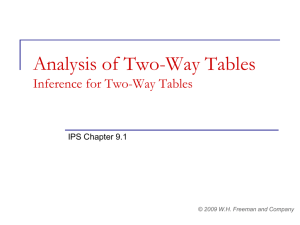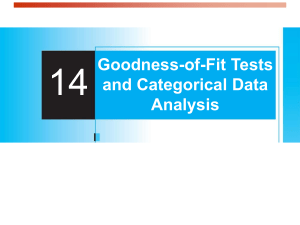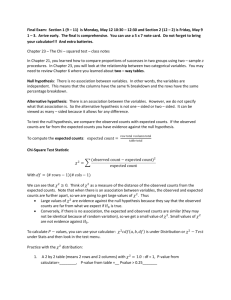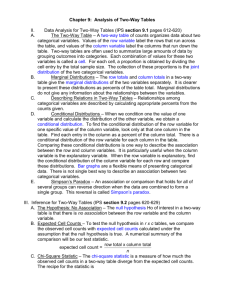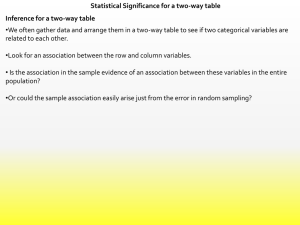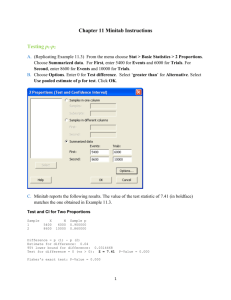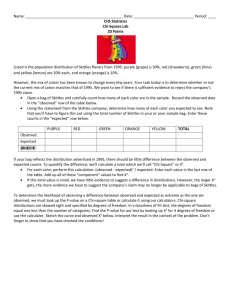Two Categorical Variables: the Chi-Square Test
advertisement
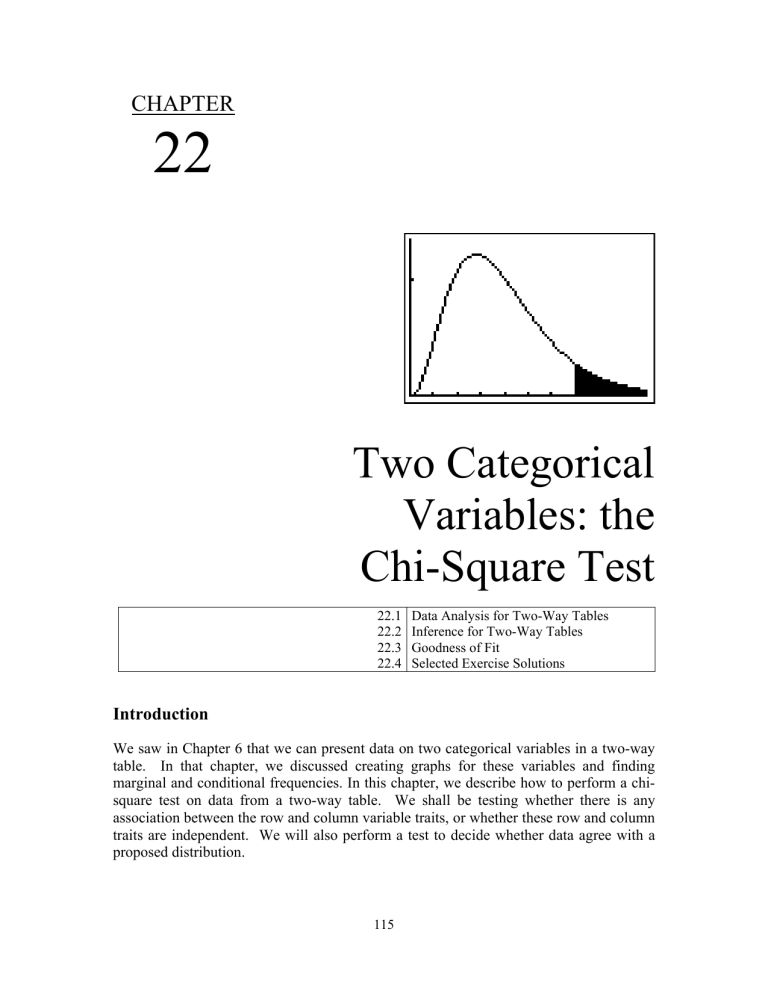
CHAPTER
22
Two Categorical
Variables: the
Chi-Square Test
22.1
22.2
22.3
22.4
Data Analysis for Two-Way Tables
Inference for Two-Way Tables
Goodness of Fit
Selected Exercise Solutions
Introduction
We saw in Chapter 6 that we can present data on two categorical variables in a two-way
table. In that chapter, we discussed creating graphs for these variables and finding
marginal and conditional frequencies. In this chapter, we describe how to perform a chisquare test on data from a two-way table. We shall be testing whether there is any
association between the row and column variable traits, or whether these row and column
traits are independent. We will also perform a test to decide whether data agree with a
proposed distribution.
115
116 Chapter 22 – Two Categorical Variables: The Chi-Square Test
22.1 Data Analysis for Two-Way Tables
Example 22.1 Where do young people live? A sample survey asked a random sample
of young adults, “Where do you live now? That is, where do you stay most often?” The
table below presents the data from all 2984 people in the sample, classified by their age
and where they live. Living arrangement is a categorical variable. Even though age is
quantitative, the two-way table treats age as dividing these young people into gour
categories.
Parents’ home
Another person’s home
Your own place
Group quarters
Other
19
324
37
116
58
5
AGE
20
378
47
279
60
2
21
337
40
372
49
3
22
318
38
487
25
9
(a) For each age, compute the conditional distribution of living arrangements.
(b Draw a bar graph of the conditional distributions.
Solution:
(a) The conditional distributions are the cell counts for each living arrangement divided
by the total number of individuals in that age group. Sum down the columns to find there
are 324 + 37 + 116 + 58 + 5 = 540 19-year-olds in the sample, 378 + 47 + 279 + 60 + 2 =
766 20-year-olds, 337 + 40 + 372 + 49 + 3 = 801 21-year-olds, and 318 + 38 + 487 + 25
+ 9 = 877 22-year-olds. Now divide each cell count to find the conditional distributions
(read down the columns) as shown below.
Parents’ home
Another person’s home
Your own place
Group quarters
Other
19
324/540 =
0.60
37/540 =
6.9%
116/540 =
21.5%
58/540 =
10.7%
5/540 = 0.9%
AGE
20
21
378/766 =
337/801 =
49.3%
42.1%
47/766 =
40/801 =
6.1%
5.0%
279/766 =
372/801 =
36.4%
46.4%
60/766 =
49/801 =
7.8%
6.1%
2/766 = 0.3% 3/801 = 0.4%
22
318/877 =
36.3%
38/877 =
4.3%
487/877 =
55.5%
25/877 =
2.9%
9/877 = 1.0%
(b) To make a (rough) bar graph of the conditional, we first enter the values 0 through 20
into list L1 in order to represent the 4 × 5 category combinations, and then enter the
conditional distributions calculated above into list L2. Next, we adjust the WINDOW (to
ensure that the bars have width 1) and STAT PLOT settings for a histogram of L1 with
frequencies L2, then s. Remember that proper bar graphs should not have bars
connected if you try to copy this down!
Inference for Two-Way Tables 117
We can see that the percent living at home declines with age and the percent living in
their own place increases with age. The percent living in group quarters (dorms?) also
declines with age.
22.2 Inference for Two-Way Tables
We continue here with an example that shows how to compute the χ2 test of no
association between the row variable and column variable in a two-way table, and obtain
the matrix of expected cell counts.
TI Calculators have a built-in χ2–Test feature (on the STAT TESTS menu) that will
compute the expected counts of a random sample under the assumption that the
conditional distributions are the same for each category type. To use this feature, we first
must enter data from a two-way table into a matrix in the MATRX EDIT screen.
Example 22.3 Where young people live: the test statistic (and expected counts).
Continuing with our example on where young adults live, under the assumption that there
is no relationship between age and living arrangements, find the expected number of
individuals living in each type of arrangement by age. Determine whether or not there is
an association between age and living arrangements.
TI-83/84 Solution. First, enter the 5 x 4 table of data (do not enter row or column totals)
into matrix [A] in the MATRIX EDIT screen. To get to this screen, press y— for
the MATRIX menu, then arrow to EDIT. Press Í to select matrix [A]. Enter the
size of the body of the matrix (rows × columns) pressing ¸ to advance the cursor.
Enter the observed counts across the rows, pressing ¸ each time to advance the
cursor. This menu is fussy – you must press y3 = 5•
to exit the editor.
Next, bring up the χ2–Test screen from the STAT TESTS menu, and adjust the
Observed and Expected names if needed. The calculator defaults for this test are
matrix [A] for Observed, and matrix [B] for Expected. If you have used another
matrix, press y— for the MATRIX NAMES screen and locate the matrix name you
used; press ¸ to select it. Next, press ¸ on Calculate.
118 Chapter 22 – Two Categorical Variables: The Chi-Square Test
TI-89 Solution. On TI-89 calculators, the Matrix Editor is an application. Press O.
Either press { or arrow down and press the right arrow to expand the options for what to
edit. If you want to reuse a matrix name with a matrix of the same size, select option
2:Open or select 3:New here. You next expand the Type: box to select 2:Matrix.
In a similar way, select a folder (usually Main) and give the matrix a name (here aa) and
its dimensions (ours is a 2x2). The matrix editor screen appears. Enter the observed
counts across the rows, pressing ¸ each time to advance the cursor. This menu is
fussy – you must press yN = •
5 to exit the editor. Return to the
Stats/List Editor application and press 2ƒ = ˆ for the Tests menu. The
test we want is option 8:Chi2 2-way. Select it and use 2| = ° to locate
and enter your matrix name in the Observed Mat box. One can normally use the
defaults for the Expected and CompMat matrices. As with the TI-83/84 series, there is
a Calculate or Draw option for the output. Output is similar to the TI-83/84, but the
first portion of the expected counts and components of the χ2 statistic are shown. To
observe these matrices fully, return to the Matrix Editor application and use the Open
option to view them. Below, the contents of Expmat (the expected counts) and
Compmat (contributions from each cell to the χ2 statistic) are shown.
Inference for Two-Way Tables 119
Conclusions. The χ2–Test feature on all these calculators displays the chi-square test
statistic, the p-value, and the degrees of freedom for the chi-square test of no association
between the row and column variables. In this case, the low p-value of 7 × 10-35
(essentially 0) gives extremely strong evidence to reject the claim that there is no
relationship between age and living arrangements of young adults. The TI-89 Compmat
(the last matrix shown above) shows us that the largest component to the overall
χ2 statistic is from 19-year-olds living in their own place – we actually had 116 of them in
the sample and 226.93 were expected.. Those are most unlike what is expected under an
assumption of no relationship.
Example 22.6 Are cell-only telephone users different? Random digit dialing telephone
surveys do not call cell phone numbers. If the opinions of people who have only cell
phone differ from those of people who still have land lines, the poll results may not
represent the entire adult population. The Pew Research Center interviewed separate
random samples of cell-only and landline telephone users. We will compare the 96 cellonly users and the 104 landline users who were less than 30 years old. What do the data
below say about type of phone and political leaning?
Cell-only Landline
Sample
Sample
Democrat or lean Democrat
49
47
Refuse to lean either way
15
27
Republican or lean Republican
32
30
Total
96
104
Solution: We test a null hypothesis that there is no relationship between phone type and
political leaning against an alternative that there is a relationship. Enter the data into a
matrix, then use the χ2 test.
The test statistic is χ2 = 3.22 with p-value 0.1999. This large p-value indicates there is no
significant difference in political leanings in this age group between those with only cell-
120 Chapter 22 – Two Categorical Variables: The Chi-Square Test
phones and those with landlines. Notice that the largest differences between the observed
and expected counts are for those who don’t lean either way.
22.3 Goodness of Fit
TI-84 and -89 calculators have a built-in function to perform the goodness of fit for a
discrete distribution. The commands for a TI-83 are simple enough, but we provide a
small program below that also will accomplish the task.
Before executing the FITTEST program that follows, enter the specified proportions into
list L1 and enter the observed cell counts into list L2. The expected cell counts are
computed and stored in list L3, and the individual contributions to the chi-square test
statistic are stored in list L4. The program displays the test statistic and the p-value.
The FITTEST Program
Program:FITTEST
:sum(L2)¿N
:N*L1¿L3
:(L2-L3)• /L3¿L4
:sum(L4)¿X
:1-χ2cdf(0,X,dim(L2)-1)¿P
:ClrHome
:Disp "CHI SQ STAT"
:Disp X
:Disp "P VALUE"
:Disp P
Example 22.8 Never on Sunday? Births are not evenly distributed across the days of the
week. Fewer babies are born on Saturday and Sunday than on other days, probably
because doctors find weekend births inconvenient. A random sample of 140 births from
local records shows this distribution across the days of the week:
Day
Births
Sun.
13
Mon.
23
Tue.
24
Wed.
20
Thu.
27
Fri.
27
Sat.
18
Do these data five significant evidence that local births are not equally likely on all days of the
week?
TI-83 Solution. If each day were equally likely, then 1/7 of all births should occur on
each day. To test the fit of this distribution, we shall use the FITTEST program. We
first enter 1/7 seven times into list L1 (the calculator displays a decimal equivalent) to
specify the expected distribution, and enter the given frequencies from the table into list
L2. Next, we run the FITTEST program to obtain a p-value of 0 from a chi-square test
statistic of 0.2689.
Selected Exercise Solutions 121
TI-84/89 Solution. Both of these calculators have built-in Chi-square goodness-of-fit
tests and they function similarly. In both cases, we enter the observed and expected
counts into two lists. The expected count under the null hypothesis (births are equally
likely each day of the week) is 1/7*140 = 20. Our observed counts have been entered
into L1 and the expected counts in L2. From the STAT TESTS menu select option
χ2GOF-Test (Chi2 GOF on a TI-89). Enter the list names for your observed and
expected counts and the degrees of freedom for the test which are k – 1, where k is the
number of categories. Since there are 7 days per week, for this example k = 7, so we
have df = 6. The TI-84 output seen below shows the contributions to the χ2 statistic.
To see all of them, use the right arrow key. The TI-89 creates a new list of components
which can be viewed in the List editor.
Conclusions. With a p-value of 0.2689, we cannot reject the null hypothesis of no
relationship between day of week and the number of births. At least in this locality, there
is no relationship.
22.4 Selected Exercise Solutions
22.13 Use program FITTEST (TI-83) or χ2GOF-Test (TI-84/89) to calculate the test. In
any case, the expected counts are 53*1/3 = 17.6667, since if the tilts made no difference,
there should be an equal number of strikes on each type of window. If you are using
FITTEST, enter the expected proportions in L1 and the observed counts in L2. With the
other two calculators, enter the observed and expected counts in two lists (you will be
asked for them). Note that for the TI-84 or -89 procedures, you need to give the degrees
of freedom which are categories–1. With a P-value of 0.0003, we conclude that tilting the
windows does make a difference in birds striking them.
22.43 This is a test of homogeneity (do all three sets of parents have the same types of
opinions). We enter the data from the body of the table into matrix [A], then use χ2Test. The differences in the distributions are statistically significant (P = 0.0042).
122 Chapter 22 – Two Categorical Variables: The Chi-Square Test
To see the departures from the null hypothesis, examine
matrix [B]. Blacks are less likely to call schools Excellent
than expected (12 observed versus 22.7 expected) while
Hispanics are more likely to call them Excellent (34
observed and 22.7 expected) and less likely to call them
Good (55 versus 68). Blacks are more likely to call them
Good (75 versus 65.4). There seems to be no real
differences among the ethnicities on calling the schools Poor.
Continue your practice with these exercises:
22.1 Facebook at Penn State.
22.3 Attitudes towards recycled products.
22.5 Facebook at Penn State.
22.15 Police harassment?
22.17 What’s your sign?
22.29 Free speech for racists?
22.45 Market research.
22.47 Party support in brief.

